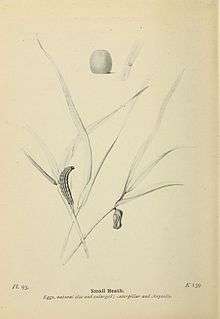Small heath (butterfly)
| Small heath | |
|---|---|
_P.jpg) | |
| in Portugal | |
| Scientific classification | |
| Domain: | Eukaryota |
| Kingdom: | Animalia |
| Phylum: | Arthropoda |
| Class: | Insecta |
| Order: | Lepidoptera |
| Family: | Nymphalidae |
| Genus: | Coenonympha |
| Species: | C. pamphilus |
| Binomial name | |
| Coenonympha pamphilus (Linnaeus, 1758) | |
The small heath (Coenonympha pamphilus) is a butterfly species belonging to the family Nymphalidae, (subfamily Satyrinae, commonly known as "the browns"). It is widespread in Eurasia and northwestern Africa, preferring drier habitats than other Coenonymphae. The larval host plants are grasses, notably sheep's fescue and rough meadow grass Poa trivialis.
Habitat
Well-drained meadow and steppe habitats. In the mountains it reaches the subalpine zone (1,500–2,000 m above sea level)

Life cycle
The egg is green at first, afterwards becoming whitish or bone-colour ; later on a brownish irregular ring appears a little above the middle, and there are various brownish freckles. It is finely ribbed, and the top is depressed, forming a hollow with a central boss. Laid in a cluster of four on a blade of grass, but this may have been accidental. Others were deposited singly on muslin and on fine grass, all in mid-June. The caterpillar is of a clear green colour, " with darker green dorsal stripe, and a spiracular stripe not so dark ; the anal points pink" (Hellins). The chrysalis is of " a delicate pale rather yellowish-green, with a faintly darker green dorsal stripe, the edge of the projecting wing-covers on each side whitish, outlined with a streak of reddish-brown ; the abdomen freckled very delicately with paler green ; the tip of the anal point, with a short streak of brownish-red on each side ; the wing-cases faintly marked with darker green nervures " (South, 1906)
The larvae have lifespans of varying length, even within the same climate, thus the imagines of one generation may be seen over a long period. The butterfly usually has two, occasionally three, broods and is on the wing from mid May until early October (late June to mid August in colder climates). The insect overwinters in its larval stage.
Decline in England
The small heath, like its cousin the wall brown, has been in serious decline across much of southern England for reasons unclear, and was accordingly designated as a UK BAP Priority Species (research only) by DEFRA in 2007.
Subspecies[1]
- C. p. lyllus (Esper, 1806) South Europe and Siberia, the Crimea, the Caucasus and Transcaucasia
- C. p. marginata Heyne, [1894] South Europe and Siberia, the Crimea, the Caucasus and Transcaucasia
- C. p. fulvolactea Verity (1926) Middle Asia
- C. p. centralasiae Verity (1926) Middle Asia
- C. p. infrarasa Verity (1926) Middle Asia
- C. p. juldusica Verity (1926) Middle Asia
- C. p. ferghana Stauder (1924) Middle Asia
- C. p. nitidissima Verity (1924) Middle Asia
- C. p. asiaemontium Verity (1924) Altai Mts
- C. p. rhoumensis Harrison (1948)
Similar species
The butterfly loosely resembles a small meadow brown, but the brown colour of the wings appears noticeably paler in flight. Unlike the meadow brown and other common members of Satyrinae, the small heath is a lateral basker, only ever resting with its wings closed and angled at 90° to the sun. It more closely resembles Coenonympha caeca (forewing without apical spots), Coenonympha tullia (forewing apical spot smaller), Coenonympha symphita (underside of hindwing without white spot and almost always with a complete row of spots on the forewing).
References
- ↑ http://www.funet.fi/pub/sci/bio/life/insecta/lepidoptera/ditrysia/papilionoidea/nymphalidae/satyrinae/coenonympha/index.html
- ↑ Brakefield, P.M.; Emmet, A.M. (1990), COENONYMPHA PAMPHILUS (Linnaeus). Pages 277–279 in Emmet, A.M., J. Heath et al. (Eds.) The Butterflies of Great Britain and Ireland. The Moths and Butterflies of Great Britain and Ireland Vol. 7 Part 1 (Hesperiidae to Nymphalidae), Harley Books, Colchester, UK. 370p.
External links
| Wikimedia Commons has media related to Coenonympha pamphilus. |
- Butterfly Conservation species page
- Images of small heath
- Small heath, Moths and Butterflies of Europe and North Africa